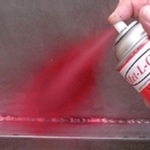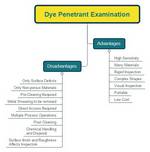Liquid penetrant inspection is used to detect any surface-connected discontinuities such as cracks from fatigue, quenching, and grinding, as well as fractures, porosity, incomplete fusion, and flaws in joints. Here is a list of standards generally followed in industry related to dye penetrant inspection.
| Sr. | Number | Title |
| 1 | ISO 3452-1 | Non-destructive testing – Penetrant testing – Part 1. General principles |
| 2 | ISO 3452-2 | Non-destructive testing – Penetrant testing – Part 2: Testing of penetrant materials |
| 3 | ISO 3452-3 | Non-destructive testing – Penetrant testing – Part 3: Reference test blocks |
| 4 | ISO 3452-4 | Non-destructive testing – Penetrant testing – Part 4: Equipment |
| 5 | ISO 3452-5 | Non-destructive testing – Penetrant testing – Part 5: Penetrant testing at temperatures higher than 50 |
| 6 | ISO 3452-6 | Non-destructive testing – Penetrant testing – Part 6: Penetrant testing at temperatures lower than 10 |
| 7 | ISO 3059 | Non-destructive testing – Penetrant testing and magnetic particle testing – Viewing conditions |
| 8 | ISO 12706 | Non-destructive testing – Penetrant testing – Vocabulary |
| 9 | ISO 23277 | Non-destructive testing of welds – Penetrant testing of welds – Acceptance levels |
| 10 | EN 1371-1 | Founding – Liquid penetrant inspection – Part 1: Sand, gravity die and low pressure die castings |
| 11 | EN 1371-2 | Founding – Liquid penetrant inspection – Part 2: Investment castings |
| 12 | EN 10228-2 | Non-destructive testing of steel forgings – Part 2: Penetrant testing |
| 13 | EN 10246-11 | Non-destructive testing of steel tubes – Part 11: Liquid penetrant testing of seamless and welded steel tubes for the detection of surface imperfections |
| 14 | ASTM E 165 | Standard Practice for Liquid Penetrant Examination for General Industry |
| 15 | ASTM E 1417 | Standard Practice for Liquid Penetrant Testing |
| 16 | ASME BPV Section V Art.6 | Liquid Penetrant Examination |
| 17 | ASME BPV Section V Art.24 | Art. 24 Standard Test Method for Liquid Penetrant Examination SE-165 (identical with ASTM E-165) |
[google-square-ad]




